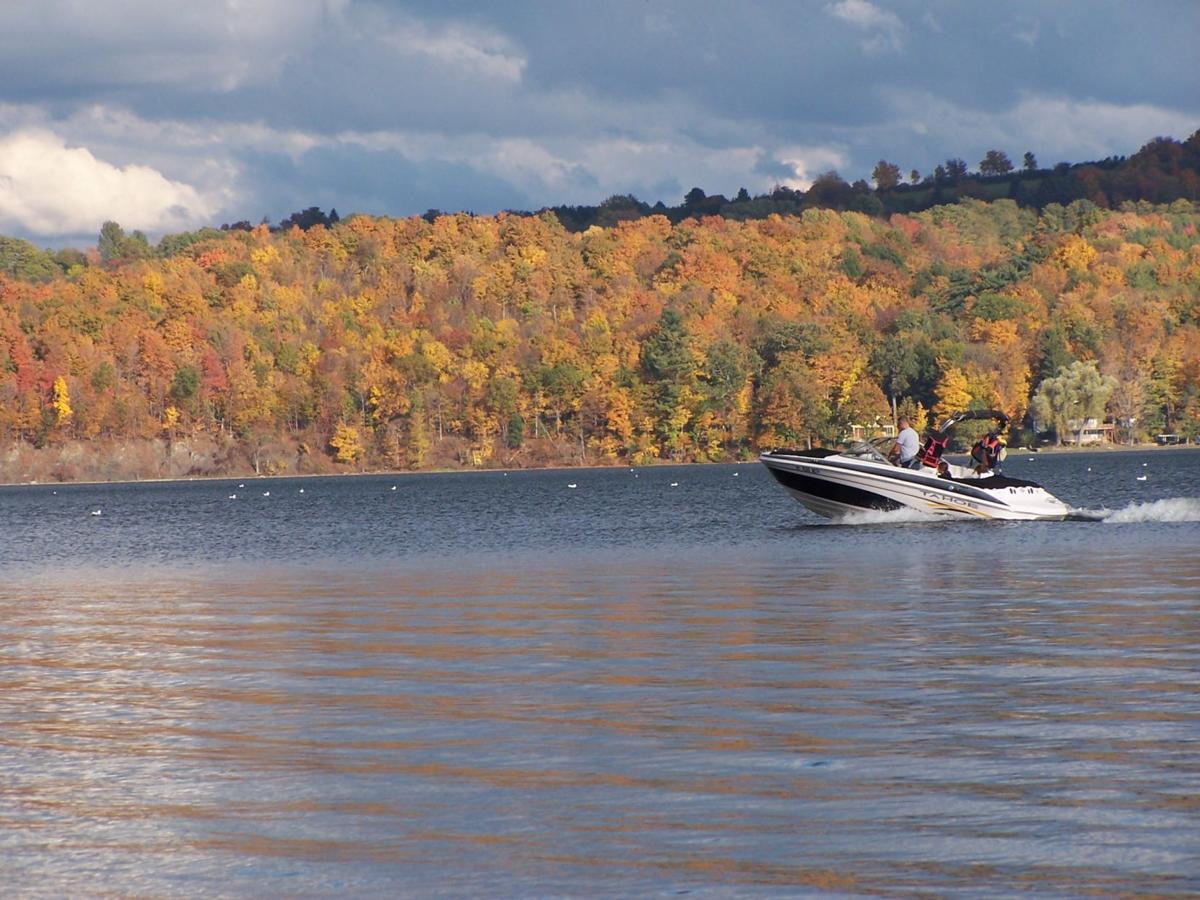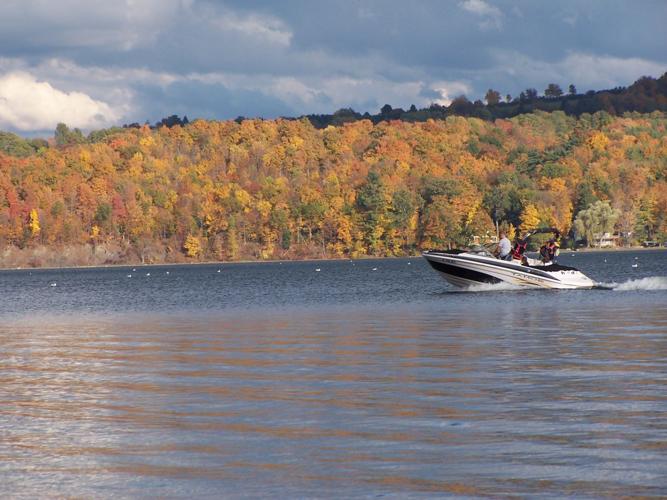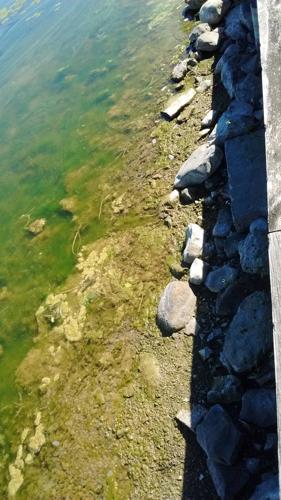After the summer solstice when the air is warm and the water is, too, Owasco Lake beckons tourists and residents alike. One of 11 Finger Lakes, it brings countless visitors to Cayuga County to swim, fish, boat and amble along its shores.┬Ā
But it's not just people who take advantage of the warming waters. Cyanobacteria, often called blue-green algae, thrive that time of year. John Halfman, a research scientist and professor of geolimnology and hydrogeochemistry at the Finger Lakes Institute at Hobart and William Smith Colleges, has been studying Owasco Lake since 2005, and he's witnessed the cyanobacteria blooms become more concentrated and more toxic over the last few years.
"These blooms love warm water, the optimum time to have tourists around Owasco Lake, unfortunately," he said.
This past summer was an especially rough one for the lake. Blooms shut down beaches, and multiple notifications from the blue-green, paint-like film that can float upward and compile into a concentrated and sometimes highly toxic bloom. The most prevalent toxin in Owasco Lake's blue-green algae, called microcystin, can cause liver failure, gastrointestinal problems and even problems to the nervous system in both humans and animals.
People are also reading…
Blue-green algae, also known as cyanobacteria, is a filmy, paint-like scum that has been dis…
It was┬Āeven more of a problem in of the city of Auburn and town of Owasco's water plants into the drinking water of tens of thousands of residents. Although at levels below the U.S. Environmental Protection Agency's health advisory guidelines, the blooms brought concerning national and state attention to one of Cayuga County's gems.
"I think the obvious reality is, we have an awful hard time promoting the toxic Finger Lake mud flats as a tourism destination," said Bob Brower, president of the Owasco Watershed Lake Association. "This region is filled with breathtaking vistas and viewsheds and clean, deep lakes. It was formed in a fascinating way, 10 to 15,000 years ago, and in the middle of that is Owasco Lake. So I think what happens in Owasco Lake is reflective of the concerns that exist throughout the Finger Lakes Region, including the potential impact that degradation of the lake could have on tourism."
Nutrient loading, specifically of phosphorous, seems to be one standout culprit for causing more algal blooms. That, combined with warming waters, heavy spring rains and the dozens of tributaries that conveniently carry rich runoff into the water body, are some of the ingredients in an algae soup recipe. And with last year's winds tending to sail from south to north, Gary Duckett, Cayuga County superintendent of parks and trails, has found Emerson Park to be a popular receiving ground for the floating bacteria.
"If the lake really was determined to be such a way that you couldn't swim or boat in it, it would have a devastating impact on our local tourism," Duckett said. "People who come to this area are coming here because of our lake.
"There are other Fingers they can go to," he added. "They don't have to go to our finger."
The park attracted more than 268,000 visitors this past year, not including those that come through during the colder months. And Emerson Park accounts for about 84 percent of visitors from all the county's parks and trails in 2016, though it arguably has more efficient methods of keeping track of visitor numbers than its sister parks like Sterling Nature Center and the Owasco Flats.
Visitors come to Emerson Park to see a show at the Merry-Go-Round Theater, to utilize the boat launch, to stroll the walkways, take a dip or sunbathe at the beach. including those for the boat launch and renting out Deauville Island for events. While the $2 parking fee has not been increased, excess revenue generated from parking and boat launch use goes into a capital reserve account for various park improvements. In total, the park generated nearly $280,000 last year.
While Duckett said blue-green algae has caused some folks to call him and ask about the lake, fortunately, he said, the bacteria has been blooming later in the season after the beaches are closed. Still, lifeguards at the park are now trained to check for bacteria blooms prior to opening the beach. If there's a suspected bloom, Duckett or another park official will call the Cayuga County Health Department to verify.

Algal blooms can be seen in the Poplar Cove area of Owasco Lake in late September.
With a disturbing trend of more toxic blooms, Brower and the lake association have discussed bulk purchasing a kind of litmus test, strips that are used to tell whether the water is toxic or not. While the test strips will not reveal how toxic the water is, Brower said it could be useful for someone hosting a party on the lake.
Eileen O'Connor, director of Environmental Health, said typically the health department does not use those test strips until 24 hours after a bloom, and cautioned that they may not be as easy as it seems. While the strip does not show a toxicity number, it shows a toxin level range through the color it turns. Public beaches are closed if the levels of microcystin are above 10 parts per billion.
While that may only be a short-term help, Brower and the association are also working on specific projects with partner organizations Brower said work on buffers and planting shrubs along tributaries and streams, among other projects that are hoped to tie up nutrients before entering the lake, will be implemented this spring and summer, and may continue into the summer of 2018.┬Ā
"When the lake is degraded, the lives of every one of us that live here permanently are diminished," he said. "So are the lives of our kids, and that matters. I guess I do care a little bit more about that than tourism, but it's in concert. We get a win-win."
If blue-green algae weren't enough of a problem to tackle, the lake hit another setback in hat looked similar to something called duck itch or swimmer's itch. the organism that causes the rash, it is possible, Environmental Health Director Eileen O'Connor had said, that it just was not found in the samples collected.
Swimmer's itch relies on a couple of things to take place. Typically a bird is the host of an adult parasite, which releases its eggs through the bird's fecal matter. This is often near water bodies. The parasitic larvae hatch, searching for an aquatic snail to proliferate inside. The snails, according to the Centers for Disease Control and Prevention, release a different larvae called cercariae, which swim around looking for a bird or other host to infect. While humans are not desirable hosts, the larvae can burrow into skin, causing the rash.┬Ā
After that event, Duckett said the department handed out pamphlets to boaters, warning them about duck itch and explaining how to protect yourself from it. That includes immediately wiping off the skin after being in the water. The them from landing in and around the lake shore. The hope is that will decrease the amount of bird feces in the lake.
For Audrey Iwanicki, one of the owners of Owasco Paddles at Emerson Park, the health of the lake is of utmost importance.┬ĀWhile the blue-green algae has stayed away from their location thus far, Iwanicki said the swimmer's itch scare did cause business to slow down. She said they are never going to send people out if there's a problem on the lake, but if they have to make that call, it closes business.
"The lake is our business," Iwanicki said. "Without it, we've got nothing."
Iwanicki and co-owner Lori Dillon have attended a Save Owasco Now lake advocacy meeting, and Iwanicki said they are doing "whatever they think we need to do."
"Owasco Lake draws a lot of people from all over," Iwanicki added. "We've had people from literally all over the world. I had a guy from England one time. He was standing on the shore, and he said, 'You are so lucky to be able to look at this every day. You don't know how lucky you are.' He didn't want to leave. We have to protect that."
Staff writer Gwendolyn Craig can be reached at (315) 282-2237 or gwendolyn.craig@lee.net. Follow her on Twitter @gwendolynnn1.



























